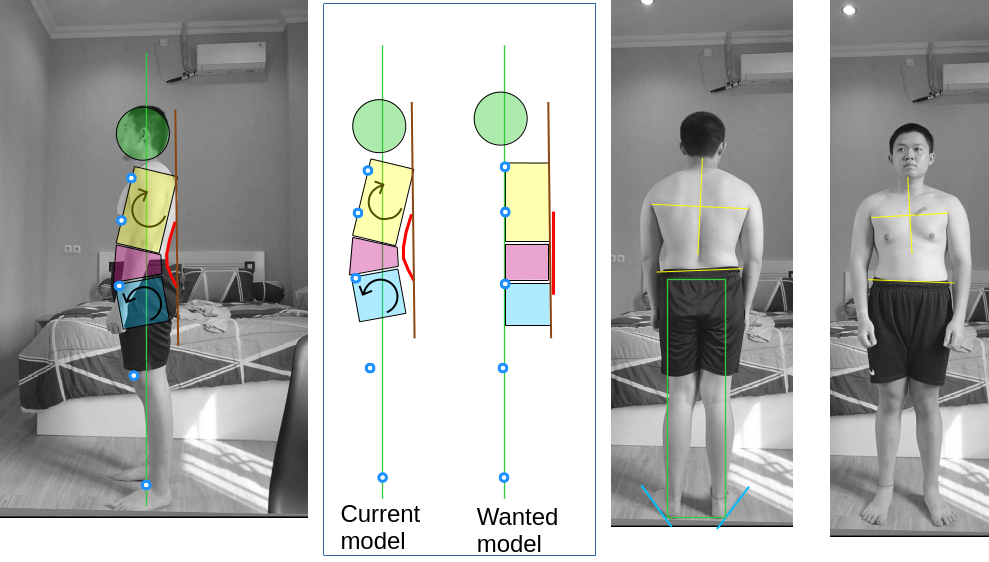Assessment request from: https://www.reddit.com/r/PostureAssesments/comments/16l37ms/help_assesment/

Here is what I see when I look at your images (btw, well captured images).
The position of your feet isn't good - your toes are too far apart. On the back view, the blue lines at the out steps or your feet are visibly converging at the back. They should be parallel.
Let's first look at your major problem - the shortening of your torso. I have outlined your torso as 3 separate parts. Lower torso (pelvis) as a blue square. Upper torso (ribcage) as a yellow rectangle. And middle torso (your abdominal cavity + spine) in purple.
The lower torso and the upper torso rotate in space in relation to each other. Pelvis (as seen on this image) rotates counterclockwise, your ribcage rotates clockwise. These two rotatating objects affect the spine inbetween, basically just bending it. - that's the red curve arch in your lowerback. Your thoracolumbar fascia is slack, not transferring any useful load. You are restricting your breathing, digestion and circulation.
Notice the blue and white markers. They are placed at specific bony spots: Front of your ankles, knees, iliacs (anterior superior iliac spine) and then bottom and top sternum. As you can see yours, they are well and truly to the front from the plumbline (which is always set to the ankle point) with all of these markers (well, except the ankle). To have a proper functioning mechanism, you would want to change this organisation to the "wanted model", where all the markers end up on the plumbline - as shown on the schema.
Further more on the side view image - you are retracting your arms too far back, and you do the same with your head.
The brown line I have drawn there, that represents the "broom stick" test. You place a broomstick on your back in such a way that you touch the sacrum at the lower end, and you touch between the shoulderblades at the other end. Then, you measure how far the back of your head is from the stick. Yours is close, we would want a fair distance there (4-6 inch maybe?). Also, you can measure the arch in your lowerback, in your case you could easily slide your hand between your spine at L3 and the broomstick. Again, we would like to have zero space there - that is, we want the lowerback to remain flat.
So most of the postural issues are seen on the side view, but the front and back view show nicely the left / right imbalances present.
You are habitually placing your left knee forward to your right, actually, it starts earlier than that, it starts with the feet. But the knees are nicely visible. The knees are also too far close to each other (making you look like you have "X" legs).
This of course then affects the rest of the mechanism as we travel upwards. Pelvis is dropped on the left side due to the shortening of the left leg by bending the knee more.
Weight is shifted onto your right side leg.
There is a collapse in the torso on the right side more so than on the left.
Left iliac (anterior superior iliac spine) is further forward compared to the right iliac.
So the bottom left side of the mechanism has a tendency to go forward. That has to be compensated somewhere, in order to maintain balance. That is why you then retract the left arm further back then the right (which shows by the left shoulder being higher).